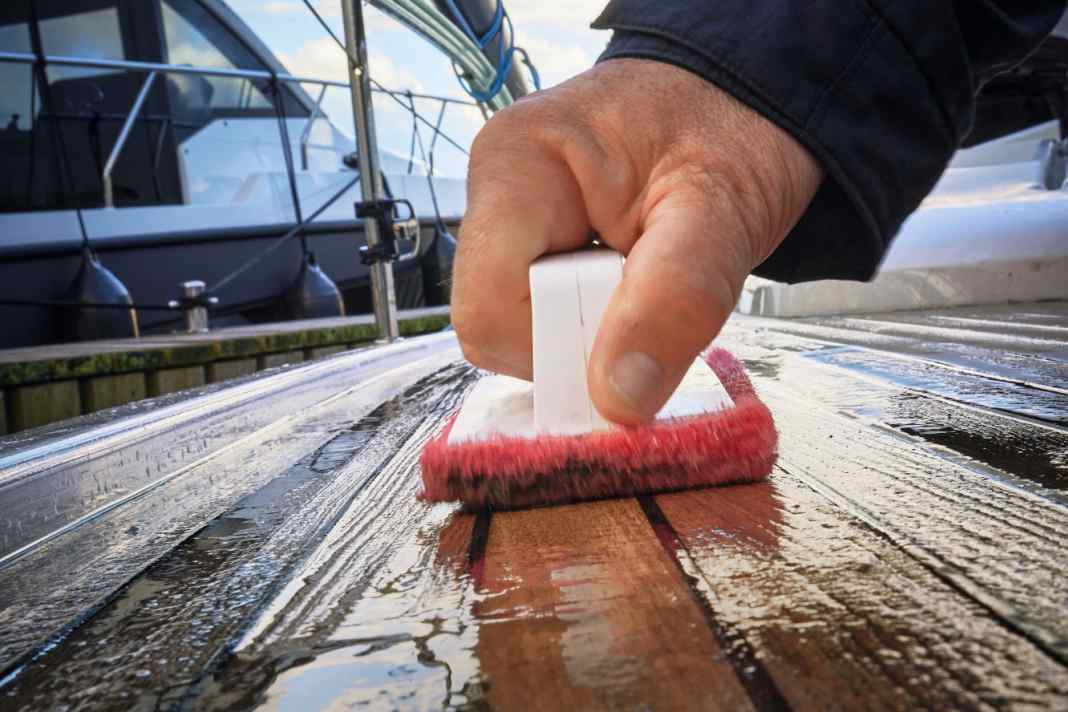Brushes, scrubbers, high-pressure cleaners: The best tools for spring cleaning on board
Jan-Ole Puls
· 17.04.2024






At the start of the season, the final maintenance work often needs to be done. Cleaning the yacht is then further down the to-do list, but is urgently needed after the winter. Sanding dust and dirt have accumulated on deck. Perhaps a bird has strayed into the hall and immortalised itself on board.
However, scrubbing is not only for beautification, but also for value retention and control. If you notice water ingress after washing, you can fix it before the damage gets worse. Spring cleaning may also be due at home, but there are a few things to consider on board that require special care or where the wrong products can even cause damage.
The right brush for the teak deck
The teak deck, for example, does not tolerate aggressive cleaning agents, high-pressure cleaners or scouring pads. These would attack the wood fibres and dissolve the oils, which would shorten the life of the deck enormously. It is better to work across the grain with a sanding pad or a soft brush. This removes most of the dirt while protecting the soft wood fibres.
The brushes are generally available in three different versions. Hard models can be used to remove very coarse dirt on plastic decks with anti-slip structures. Medium brushes are ideal for normal cleaning of the boat. This also works with the softer scrubbers, but they are particularly suitable for painted surfaces, window panes, teak decks, highly polished metals and silicone antifouling.
Boat scrubber: Fringed bristles for better cleaning
In contrast to many household brushes, boat scrubbers usually look frayed from the factory. "The tips of the bristles are split, this splitting increases the surface area and the cleaning performance is higher," says Sven Münch, Sales Manager at Yachticon.
Scrubbers with an integrated water connection are particularly helpful. The dirt is rinsed away straight away. A telescopic handle is also practical so that the scrubber can be stowed away in a small space in the back box. Models with interchangeable heads also help to save space if they also function as boat hooks.
To be able to clean edges and corners well, the bristles should protrude sideways over the brush head. Another advantage: they act as shock absorbers so that you don't create any scratches when scrubbing the deck vigorously.
Is manual scrubbing too tedious? There are electric brushes for this, for example from E-Scrubber. The battery-operated device is waterproof down to a depth of three metres and can therefore also be used to clean the underwater hull. It is available for around 230 euros. Attachments for standard cordless screwdrivers are significantly cheaper, costing around 15 euros.
The right cleaning agent for your boat
To increase the cleaning effect, it is recommended that you also use a boat shampoo. This is available from various manufacturers. Most are mild cleaners. They do not attack paintwork or old coatings, so there is no need to re-wax. Many shampoos already contain a small amount of wax, which makes the water bead up better after washing. However, this protection wears off again within a few weeks.
A lasting shine can only be achieved by polishing. A GRP basic cleaner should be used for this purpose. This thoroughly removes oils and old wax. Then polish and apply new wax or a polymer sealant. This will protect the gelcoat from dirt and UV radiation for up to one season of normal use.
The following applies to stainless steel parts such as railing supports, anchors and other fittings: the saltier the water, the faster flash rust develops. A polishing and preservative agent is therefore important to maintain the shine for a long time.
Limescale and dirt form yellowish deposits, especially at the water pass. Oxalic acid-containing cleaners such as Antigilb help against both. Apply, leave to work and rinse off with water and a sponge. Antigilb is available from various suppliers and removes traces of rust as well as limescale. If the infestation is not too severe, you can try household products: Citric acid can not only dissolve the limescale from the kettle, but also from the water pass. However, as with all agents, it is important to rinse thoroughly.
Cleaning windows and hatches
When it comes to windows, it depends on the material. Glass panes can be cleaned as at home. Plastic hatches, on the other hand, should only be cleaned with plenty of water. Cleaners that are too harsh or contain solvents can blind the panes. Small round brushes are recommended for drainage openings in hatches or coamings.
It is important to know the diameter of the pipe to be cleaned, as the brushes can usually only be compressed a little before they get stuck in the pipe. If the brush is much too thin, it will not clean on all sides.
Caution when using high-pressure cleaners
High-pressure cleaners should be used with caution. They should never be used for wooden parts.
Cordless tools are particularly suitable for use on board. We tested the Gloria Multijet model and the Makita HW001GZ. Both are self-priming, meaning they do not require a hose connection. The Gloria Multijet is perfectly adequate for rinsing the deck or anchor chain, although strictly speaking it is only a medium-pressure cleaner as it only works at 25 bar. The device costs around 160 euros.
If more stubborn dirt needs to be tackled, more pressure is required. We recommend the Makita high-pressure cleaner, which can reach up to 115 bar. This corresponds to the output of simple 230-volt appliances. However, at around 620 euros, its price is also on a par with professional appliances, especially as the matching battery pack costs a further 300 euros.

